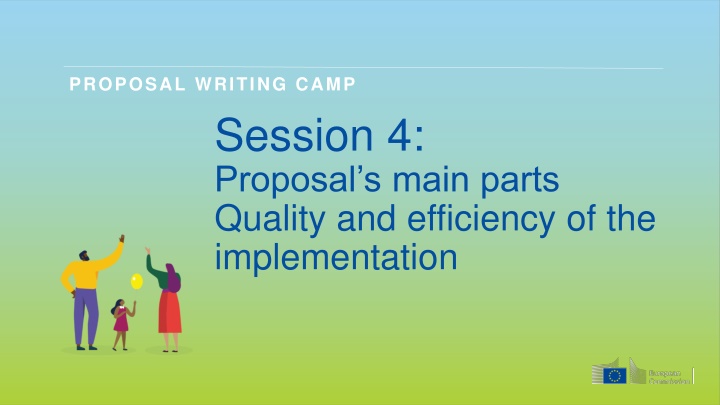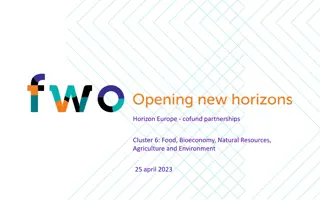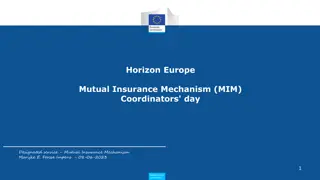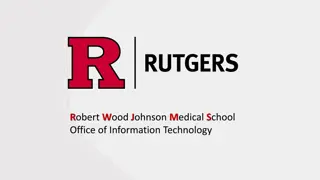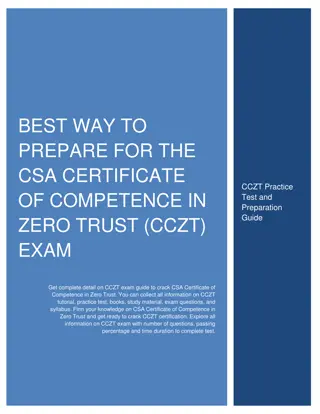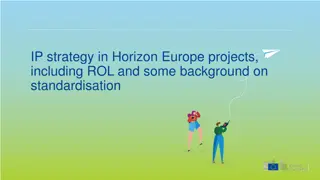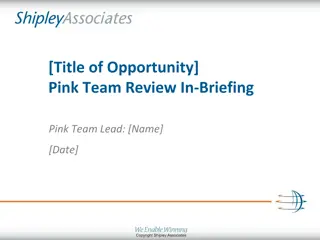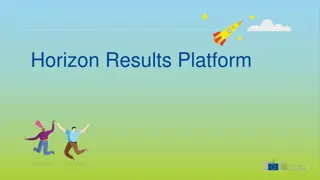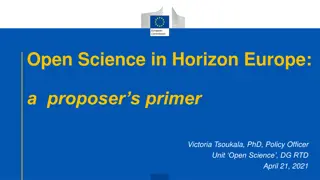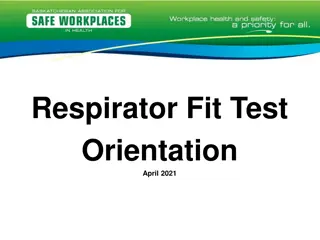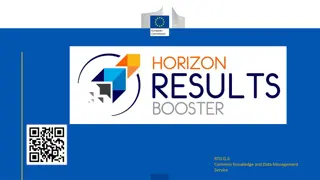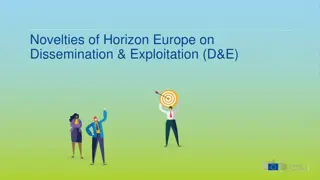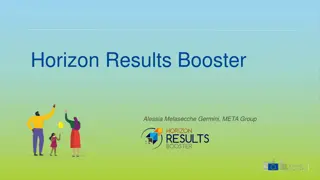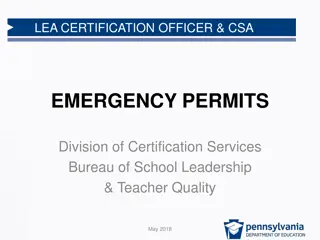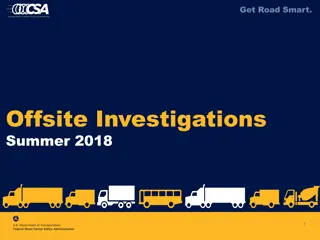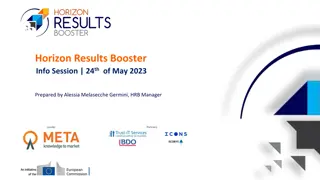Efficient Implementation Strategies in Proposal Writing for Horizon Europe CSA Projects
Explore the key components of quality and efficiency in implementing Horizon Europe CSA proposals, focusing on work plan structure, resource allocation, and consortium capacity. Learn how to present a compelling work plan, create Gantt and Pert charts, and optimize project impact and dissemination strategies.
Download Presentation

Please find below an Image/Link to download the presentation.
The content on the website is provided AS IS for your information and personal use only. It may not be sold, licensed, or shared on other websites without obtaining consent from the author.If you encounter any issues during the download, it is possible that the publisher has removed the file from their server.
You are allowed to download the files provided on this website for personal or commercial use, subject to the condition that they are used lawfully. All files are the property of their respective owners.
The content on the website is provided AS IS for your information and personal use only. It may not be sold, licensed, or shared on other websites without obtaining consent from the author.
E N D
Presentation Transcript
PROPOSAL WRITING CAMP Session 4: Proposal s main parts Quality and efficiency of the implementation
Example: structure of a HORIZON EUROPE CSA (Coordination and support action) Part A (online form) Administrative forms 1.Excellence 2.Impact 3.Quality and efficiency of implementation ->additional Annex with information on financial support to third parties (if applicable) Part B (to be uploaded as pdf PDF)
STRUCTURE OF THE PROPOSAL - PART B (CSA)B 1. Excellence 1.1 Objectives 1.2 Coordination and/or support measures and methodology PAGE LIMIT! 30 pages (CSA) allways use the applicaiton from linked to the call (FTP) 2. Impact 2.1 Project s pathways to impact 2.2 Measures to maximise impact Dissemination Exploitation and Communication 2.3 Summary 3. Quality and efficiency of the implementation 3.1 Work plan and Resources 3.2 Capacity of participants and consortium as a whole
B3. Quality and efficiency of the implementation 3.1 Work plan and Resources (14 pages including all tables / 19 pages for topics using lump sum funding) 3.2 Capacity of participants and consortium as a whole (3 pages) Award criteria aspects to be taken into account Quality and effectiveness of the work plan, assessment of risks, and appropriateness of the effort assigned to work packages, and the resources overall Capacity and role of each participant, and extent to which the consortium as a whole brings together the necessary expertise.
B3.1 Work plan and Resources Content: brief presentation of the overall structure of the work plan; timing of the different work packages and their components (Gantt chart or similar); graphical presentation of the components showing how they inter-relate (Pert chart or similar). detailed work description, i.e.: a list of work packages (tables 3.1a); a description of each work package (table 3.1b); a list of deliverables (table 3.1c);
B3.1 Work plan and Resources PERT chart - example:
B3.1 Work plan and Resources GANTT chart - example: Project XX First reporting period Second reporting period Reporting Period 1 2 3 4 5 6 7 8 9 10 11 12 13 14 15 16 17 18 19 20 21 22 23 24 25 26 27 28 29 30 31 32 33 34 35 36 Month List of Work packages & Tasks WP/Task /Activity Lead WP 1 Measurement System and Methodology XX MS1 D1.1 Task 1.1 Developing an impact assessment for project case studies Task 1.2 Metastudy of available studies on SI and energy XX D1.2 XX Task 1.3 Collecting a baseline scenario: studying social innovation practice in energy in the national context of project partners and beyond D1.3 XX WP2 Case Studies Assessment XX MS2 D2.1 T2.1 Assessment round 1: Applying the assessment system to ongoing cases XX D2.2 T2.2 Revising the impact assessment system XX D2.4 T2.3 Online database of cases XX D2.3 T2.4 Assessment round 2: applying the revised assessment system XX WP3 Real-time Experimentation with Scale-up Cases XX D3.1 T3.1 Real time experimentation through scale-up case implementation XX MS3 D3.2 D3.4 T3.2 Monitoring, real-time measurement and impact assessment of scale-up cases XX D3.3 T3.3 Training and Advice XX WP4 Outreach, Recommendations, Policy Advice, Sustainability XX D4.1 T4.1 Elaborating practical recommendations T4.2 Integrating recommendations in the policy making process and implementation of SI for energy: Outreach and Networking XX D4.2 XX MS4 D4.3 T4.3 Foresight for policy roadmaps XX D4.4 T4.4 Publications XX D4.5 T4.5 Sustainability WP5 Project Management and Dissemination T5.1 Scientific Coordination, Project Management and Internal Communication, Steering Board XX XX XX D5.2 D5.3 D5.5 T5.2 Quality and Conflict Management, Ethics Requirement, Data Management T5.3 Advisory Board XX XX T5.4 Elaboration and Implementation of Dissemination Plan, and Exploitation Strategy D5.1 D5.4 XX T5.5 Development, maintenance and regular update of the project web site XX Duration of the Task (in months) Duration of the WP (in months)
Workpackage IMPACTS (short, medium,long-term) Tasks Activities Deliverables Target GROUPS Milestones KPI STAKEHOLDERS
B3.1 Work plan and Resources (2) Content: a list of milestones (table 3.1d); a list of critical risks, relating to project implementation, that the stated project's objectives may not be achieved. Detail any risk mitigation measures. You will be able to update the list of critical risks and mitigation measures as the project progresses (table 3.1e); a table showing number of person months required (table 3.1f); a table showing description and justification of subcontracting costs for each participant (table 3.1g); a table showing justifications for purchase costs (table 3.1h) for participants where those costs exceed 15% of the personnel costs (according to the budget table in proposal part A); if applicable, a table showing justifications for other costs categories (table 3.1i); if applicable, a table showing in-kind contributions from third parties (table 3.1j).
B3.2 Capacity of participants and consortium as a whole Describe the consortium. How does it match the project s objectives, and bring together the necessary disciplinary and inter-disciplinary knowledge. Show how this includes expertise in social sciences and humanities, open science practices, and gender aspects of R&I, as appropriate. Include in the description affiliated entities and associated partners, if any. Show how the partners will have access to critical infrastructure needed to carry out the project activities. Describe how the members complement one another (and cover the value chain, where appropriate) In what way does each of them contribute to the project? Show that each has a valid role, and adequate resources in the project to fulfil that role.
B3.2 Capacity of participants and consortium as a whole (2) If applicable, describe the industrial/commercial involvement in the project to ensure exploitation of the results and explain why this is consistent with and will help to achieve the specific measures which are proposed for exploitation of the results of the project (see section 2.2). Other countries and international organisations: If one or more of the participants requesting EU funding is based in a country or is an international organisation that is not automatically eligible for such funding (entities from Member States of the EU, from Associated Countries and from one of the countries in the exhaustive list included in the Work Programme General Annexes B are automatically eligible for EU funding), explain why the participation of the entity in question is essential to successfully carry out the project.
International cooperation in Horizon Europe Work Programme 2021-2022 Partner Search TOOLS Use existing contacts with experience of EU funding programmes Use Partner Search on the Funding and tenders portal: https://ec.europa.eu/info/funding- tenders/opportunities/portal/screen/how-to-participate/partner-search Search the CORDIS database for participants in similar projects in FP7/H2020/HE: http://cordis.europa.eu/projects/home_en.html Use social media (e.g. LinkedIn forums) European NCP networks, National NCPs, COST actions https://ec.europa.eu/info/funding- tenders/opportunities/portal/screen/support/ncp https://www.cost.eu/cost-actions-event/browse-actions/
